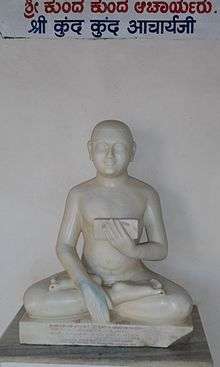Acharya
In Indian religions and society, an acharya (IAST: ācārya) is a preceptor or instructor in religious matters; founder, or leader of a sect; or a highly learned person or a title affixed to the names of learned people.[1] The designation has different meanings in Hinduism, Buddhism and secular contexts.
Acharya is sometimes used to address a teacher or a scholar in any discipline, e.g.: Bhaskaracharya, the mathematician.
Etymology
The Sanskrit phrase Acharam Grahayati Acharam Dadati Iti Va means Acharya (or teacher) is the one who teaches good conduct to one's students.[2][3] A female teacher is called an achāryā, and a male teacher's wife is called an achāryāni [4]
In Hinduism
In Hinduism, an acharya (आचार्य) is a formal title of a teacher or guru, who has attained a degree in Veda and Vedanga.[5]
Prominent acharyas in the Hindu tradition are as given below :
Buddhism
In Buddhism, acharya is a senior teacher. Notable acharyas:
- Pema Chödrön (b. 1936) acharya at Gampo Abbey[11]
In Jainism

In Jainism, an acharya is the highest leader of a Jain order. Acharya is one of the Pañca-Parameṣṭhi (five supreme beings) and thus worthy of worship. They are the final authority in the monastic order and has the authority to ordain new monks and nuns. They are also authorized to consecrate new idols, although this authority is sometimes delegated to scholars designated by them.
An acharya, like any other Jain monk, is expected to wander except for the Chaturmas. Bhaṭṭārakas, who head institutions, are technically junior monks, and thus permitted to stay in the same place.
In scientific/mathematical scholarship
- Bhaskaracharya
- Mahaviracharya
- Bhaskaracharya I
Acharya (degree)
In Sanskrit institutions, acharya is a post-graduate degree.[12]
References
- Platts, John T. (1884). A dictionary of Urdu, classical Hindi, and English. London: W. H. Allen & Co.
- Vinod Singh (1 October 2018). Higher Education for Sustainable Development and Millennium Development Goals. CCLP Worldwide. pp. 282–. ISBN 978-93-5321-685-6.
The role of Guru or Acharya was also very significant in this traditional education system. The word 'Acharya' can be derived as 'Acharam Grahayati Acharam Dadati Iti Va'. It means- Acharya or teacher is that who teaches good behavior to his pupils
- Ram Nath Sharma; Rajendra Kumar Sharma (1996). History of Education in India. Atlantic Publishers & Dist. pp. 35–. ISBN 978-81-7156-599-3.
- Suhas Chatterjee (1998). Indian Civilization and Culture. M.D. Publications Pvt. Ltd. pp. 273–. ISBN 978-81-7533-083-2.
- Ram Nath Sharma; Rajendra Kumar Sharma (1996). History of Education in India. Atlantic. p. 35. ISBN 8171565999.
- [viswakarma community] Although famous for being the proponent of advaita vad, he established the supremacy of bhakti to Krishn.
- He propagated the bhakti of Bhagwan Vishnu. Source: Ramanujacharya Archived 26 August 2007 at the Wayback Machine
- His philosophy is called dvaita vad. His primary teaching is that "the only goal of a soul is to selflessly and wholeheartedly love and surrender to God" Source:
- His writings say that Radha Krishna are the supreme form of God.
- Times, a Staff Writer, News India. "More than 40 universities from Uttar Pradesh join in felicitating a Sanskrit scholar | News India Times". Retrieved 22 November 2019.
- "Ani Pema Chödrön". Gampo Abbey. Archived from the original on 24 March 2013. Retrieved 21 October 2014.
- "Nandan Mishra vs University Of Delhi & Ors on 12 May, 2015". indiankanoon.org. Retrieved 18 September 2017.
External links
| Wikimedia Commons has media related to Acharya. |
